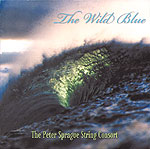
|
|||
|
|||
| Home |
| Gallery |
| Culture/ Technology |
| Fiction |
| Music |
| Poetry |
| Theater |
| What's New |
| About/Contact |
| Archive |
|
Finding the common ground between jazz, classical Reviewed November 2009
Interest in melding jazz and classical isn't anywhere near what it was in the 1920s and '30s, or again in the '70s. Practitioners of both styles today struggle simply to survive in an age when young people are more interested in the latest musical flavor of the month than in much in the way of serious music. As ambitious a recording project as local jazz guitarist Peter Sprague has yet tackled, the first CD from his Peter Sprague Jazz Consort seamlessly – and seemingly effortlessly – takes in both jazz and classical, recalling the heyday of efforts to find a way to marry the structure of European classical music with the free-wheeling improvisation of American jazz. not just straddling what are generally considered disparate styles and traditions, but blending them into a new whole, Sprague and his colleagues have crafted their own entry in the short list of projects that have succeeded at creating a common meeting ground. That Sprague includes two compositions here that also bring in classical Indian music – which has been successfully paired with the radically different traditions from the West even more rarely – and makes them work is testament to his ability to hear the common threads in all music. As with Chick Corea's 1980s string projects (which Sprague cites as an influence in the liner notes), the Peter Sprague String Consort mixes a jazz rhythm section (drums, bass and guitar in this case) with a standard string quartet (two violins, viola, cello). More importantly, the compositions and arrangements take ideas from both the jazz and classical idioms and try them out in new, interesting ways. In voicing, in harmony, in the structure of the songs themselves, Sprague draws from both traditions, mixing and matching at will. In addition to his facility with the music, there is one other secret to Sprague's success on this project: Wise recruiting. Having longtime collaborators Bob Magnusson (bass) and Duncan Moore (drums) on board helps immensely – particularly given their virtuosic talents on their respective instruments. The opening track, taking its title from that of the album, opens with a modern classical movement: stark, pared-down, with the melody carried on violin before the rest of the consort joins in. There is then a nice passage of quick, darting calls and responses between the violins and viola and the Sprague's guitar before the song settles into a kind of Brazilian chamber groove. Interestingly, the only classical composition on this set, Bach's "Prelude Number 9," opens with a soft samba lead by Sprague, then devolves into a modernist vein before finally getting a straight chamber quartet reading, and then heading back into a Latin jazz style. Sprague's "Mahavishnu" is a tribute to jazz guitarist John McLaughlin, one of the few to ever bridge Indian music with Western forms. This work is steeped in Indian melodic construction, and aural flavoring from Ron Wagner's tablas and Sprague's own turn on the tamboura, a stringed relative of the better known sitar. The main theme is carried at different times on acoustic guitar, by the violins and viola, and the tamboura. Other highlights are a Sprague-penned tribute to The Beatles that captures the feel of their music, in a mostly classical setting; a chamber blues in which Sprague plays a rhythm-driven swing-style lead on electric guitar; and a nice reading of "The Duke," Dave Brubeck's tribute to Ellington which is the closest to a pure jazz number here. For those listeners who find this release, it's a neat treat to hear talented folks following their curiosity rather than the latest trend. Review by Jim Trageser. Jim is a writer and editor living in Escondido, Calif., and was a contributor to the "Grove Press Guide to Blues on CD" (1993) and "The Routledge Encyclopedia of the Blues" (2005). |
Copyright © Turbula.net

